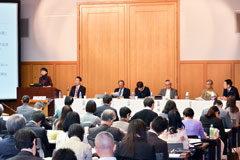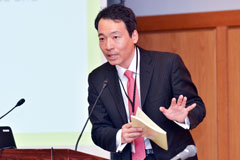Seminar Looks at Achievements in Kaizen Research and Future Issues
2019.02.18
On Dec. 25, 2018, the JICA Research Institute (JICA-RI) co-sponsored with the Japan Society For International Development (JASID) a seminar to commemorate the publication of "Achievements and Further Issues in Kaizen Research for International Development" (Japanese language only), a special issue of JASID's Journal of International Development Studies, Vol.27, No.2.

Panelists engaged in lively discussion
In developing countries, "Kaizen" refers to Japanese-style management methods introduced in various fields, including not only support for entrepreneurs but also occupational training, medical treatment and rural development. These efforts had not been discussed in a multidisciplinary way much before, but with the publication of this special issue, the possibilities of Kaizen and future issues in international development were examined, for the first time, from an interdisciplinary approach.
JICA-RI Director Izumi Ohno spoke at the beginning of the seminar, saying, "We would like to share the points reached in Kaizen research in international development so far and discuss future issues." Next Hiroshi Sato, a former president of JASID and chief senior researcher at the Institute of Developing Economies, Japan External Trade Organization (IDE-JETRO), said, "This seminar is an experiment in talking about Kaizen from various standpoints and sharing the breadth of the topic."
At the seminar, Go Shimada, the editor of this special issue, a JICA-RI visiting scholar and associate professor at the School of Information and Communication, Meiji University, talked about the intent of the special issue and the academic positioning of each of the articles in the volume. The seminar then proceeded with the author of each article introducing its content.

Go Shimada, a JICA-RI visiting scholar
In Session 1, entitled, "Beginning with Current Kaizen Assistance," Akihiko Kodama, Industrial Development and Public Policy Department, JICA, who wrote an article entitled "Cooperation on Kaizen: So Far, Now, and Then?," gave the first presentation. From the standpoint of a practitioner, he spoke about trends and lessons from JICA's Kaizen assistance in the private sector in developing countries. He told attendees that JICA would speed up the dissemination of Kaizen using "The Kaizen Handbook" published in 2018 and promoting e-learning. Furthermore, he said that JICA would aim for more comprehensive assistance by forming a platform that includes promoting entrepreneurship and improving access to funding, with the goal of achieving radical innovation.
Ohno, who wrote "Industrial Policy and Kaizen: From Practical Experience in Ethiopia and Industrial Policy Dialogue," analyzed the main factors that led to Kaizen succeeding as a national project in Ethiopia and touched on the importance of looking beyond Kaizen for the next step (“Kaizen plus”). She stressed the importance of considering Kaizen holistically rather than treating it in isolation. This should include, for example, the viewpoint of industrial policy. She added that there is also a need to analyze how to disseminate and scale up Kaizen in the unique contexts of different countries.
JICA-RI Senior Research Advisor Akio Hosono, who wrote "Kaizen and Learning: From the Viewpoint of 'Quality Growth'," said that the most salient feature of Kaizen is increasing productivity through participatory learning, and that Kaizen contributes to innovation as well by increasing corporate capacity.
In Session 2, entitled, "From the Standpoint of Education and Social Development," Shoko Yamada, a professor at Nagoya University and one of the authors of "The Effect of Non-cognitive Skills on Comprehensive Capacities of Workers: KAIZEN Education and Workers of Garment Industry in Ethiopia," gave the first presentation. Taking up the case of the textiles industry in Ethiopia, she said Kaizen capacity is hard to acquire through short-term intensive training offered at the workplace, but results can be found through long-term education at vocational school and interventions in everyday work. At the same time, since the type of attitude expected in workplaces varies with the industry and situation, there is a need to examine expectations about Kaizen skills in their respective contexts.
Sato gave an introduction to the history of livelihood improvement in rural villages in Japan and to Japan's approach of livelihood improvement in its assistance to developing countries. The presentation was entitled, "Is the Relationship Between Livelihood Improvement and Total Quality Control the Same as That Between Sakuranbo and Cherries?" He proposed that it would be meaningful to explore an East Asian development approach by doing joint research with countries such as Korea and China that are implementing assistance to developing countries.
In Session 3, entitled, "Historical Consideration of Kaizen," Shimada, who wrote, "The US Strategy for Productivity Improvement in Japan after World War II with a Focus on Labor Unions," talked about the United States' postwar assistance to Japan. He said the assistance was very strategic and large-scale. On the Japanese side, it was the private sector that played a central role in receiving aid from the U.S. While companies accepted the aid, collaboration between labor-management relations was developed in Japan, which suggests Kaizen can be implemented in other countries.
Toru Yanagihara, an honorary professor at Takushoku University and one of the authors of "The Formation and Expansion Process of Support Structures for Productivity/Quality Improvement: Japan, Singapore and Tunisia" shared the results of a comparative study conducted collaboratively with his co-authors. He compared and contrasted the experiences of the three countries in the development of a support system for the improvement of productivity and quality, characterizing Japan as private sector-led, Singapore as government-led, and Tunisia as donor-led.
Finally, all the speakers took part in a panel discussion in which they vigorously debated topics including whether Kaizen can still be effective in assistance for developing countries today when AI-technology-based innovation is moving forward; whether we should use the word “Kaizen” when it involves other donors; what steps are involved in making Kaizen useful for industrial development and what must be done to scale up Kaizen; and whether a division of labor between education in schools and in-house education like Japan's would work in Africa. Audience members asked a variety of questions including how to scale up the results achieved so far and how to apply Kaizen to Japan's regional vitalization activities.

事業事前評価表(地球規模課題対応国際科学技術協力(SATREPS)).国際協力機構 地球環境部 . 防災第一チーム. 1.案件名.国 名: フィリピン共和国.

事業事前評価表(地球規模課題対応国際科学技術協力(SATREPS)).国際協力機構 地球環境部 . 防災第一チーム. 1.案件名.国 名: フィリピン共和国.

事業事前評価表(地球規模課題対応国際科学技術協力(SATREPS)).国際協力機構 地球環境部 . 防災第一チーム. 1.案件名.国 名: フィリピン共和国.

事業事前評価表(地球規模課題対応国際科学技術協力(SATREPS)).国際協力機構 地球環境部 . 防災第一チーム. 1.案件名.国 名: フィリピン共和国.

事業事前評価表(地球規模課題対応国際科学技術協力(SATREPS)).国際協力機構 地球環境部 . 防災第一チーム. 1.案件名.国 名: フィリピン共和国.
scroll